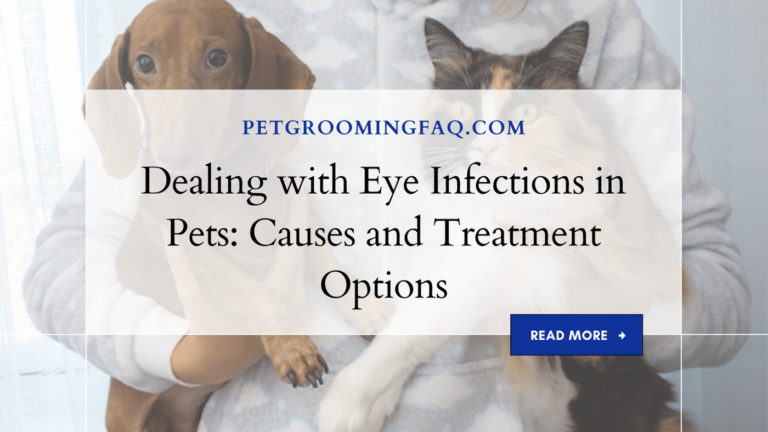When to Seek Emergency Care for Your Pet's Ear or Eye Problems.
As pet owners, we all want our furry friends to be in the best of health. However, sometimes accidents happen or illnesses arise that require emergency care. Ear and eye problems are common among pets and can cause discomfort and even lead to serious complications if left untreated.
In this blog post, we’ll explore when it’s necessary to seek emergency care for your pet’s ear or eye problems so you can ensure they receive the treatment they need as quickly as possible. So grab a cup of coffee and get ready to become an expert at recognizing when your pet needs immediate attention!
Introduction
When to Seek Emergency Care for Your Pet’s Ear or Eye Problems
If your pet is exhibiting any of the following symptoms, seek emergency care:
- A continuously excessive amount of discharge from the ear or eye
- Redness, swelling, or pain in the ear or eye
- inability to see or focus in one or both eyes
There is no single answer when it comes to determining when to seek emergency care for a pet’s ear or eye problems. Each situation is unique and requires an individual assessment. However, some general guidelines include: if any of the aforementioned symptoms are severe, persistent, and/or accompanied by other signs such as seizures; fever; increased thirst; vomiting; difficulty eating; loss of appetite; drowsiness; incoordination; CNVI (central nervous system injury); facial paralysis/weakness and/or lameness then immediate attention should be sought.
What is an Ear Infection?
Ear Infections are a common problem in pets. They can result from a variety of things, including swimming in contaminated water, fighting with another animal, or being around infected people or animals. If your pet has an ear infection, there are a few things you can do to help them get better as quickly as possible.
Depending on the severity of the infection, you may need to take your pet to the veterinarian for antibiotics or surgery. Ear infections can also be difficult to treat and can often lead to lasting damage if not treated properly. If you’re concerned about your pet’s ear infection, be sure to take them to the veterinarian for an evaluation as soon as possible!
Symptoms of an Ear Infection in Pets
Ear infections are a common ailment in pets, but there are different degrees of severity. If your pet is experiencing persistent difficulty hearing or breathing, you should seek emergency care. Other symptoms of an ear infection include discharge from the ears, fever, and neck stiffness.
Some breeds are more prone to ear infections than others, so it’s important to examine your pet for any clues before making a decision about whether to take them to the vet.
How to Treat an Ear Infection in Pets
If your pet has an ear infection, there are several things you can do to help them get better as quickly as possible. Clean the infected area with a damp cloth often and avoid using harsh soaps or cleansers. Amoxicillin or other penicillin-based antibiotics will help to treat an ear infection in pets. However, if the pet is having significant pain, drainage from the ear, fever, or redness near the ear, seek emergency care.
When to Seek Emergency Care for Your Pet’s Eye Problems

If your pet’s eye or ear problems don’t get better with over-the-counter products, see a veterinarian. If the symptoms are severe, may require surgery. The following are some signs to watch for:
1] Your pet solicits attention by staring abnormally
2] The eye or ear is red, swollen, and painful
3] There is discharge from the eye or ear
4] The pupil is enlarged and fixed
5] There is a change in pigmentation around the eye or ear
Symptoms of an Eye Infection in Pets
If you notice any redness, discharge, itchiness, or pain in your pet’s eyes or ears, take them to the veterinarian as soon as possible for an evaluation. Signs of an eye infection can include watery eyes and a decreased sense of sight. In Pets with ear infections, symptoms may include increased noise from the ear or difficulty hearing. If left untreated, both eye and ear infections can lead to permanent damage and even death.
How to Treat an Eye Infection in Pets
The first step is to determine if your pet has an existing eye infection or if the infection is new. If your pet has an existing eye infection, treatment will depend on the severity of the infection and your pet’s age, health, and ID. If you have a suspicion that your pet may have an eye infection, take them to the veterinarian for an exam as soon as possible.
If your pet does not have an existing eye infection, begin by rinsing their eyes with warm water several times a day. Treat any active infectious eye discharge with a prescribed ophthalmic antibiotic ointment (such as flagyl).
Apply a bandaid to the eye to keep it dry while wearing the ointment. Repeat this procedure every four hours while awake and at night. If the infection is severe, your veterinarian may prescribe systemic antibiotics (given orally or through a feedings tube) along with oral ointments and/or bandaids.
How to Treat an Eye Infection in Pets

If your pet has an eye or ear infection, the first step is to seek emergency care. If you can’t take your pet to the veterinarian, try to find a veterinary ER that will treat them without admitting them to the hospital. However, if your pet is already admitted to the hospital, make sure they receive all of the treatment they need for their eye or ear infection. Your veterinarian may also prescribe antibiotics if needed.
When to Suspect a More Serious Problem with Your Pet’s Ears or Eyes
If your pet is not responding to gentle petting, has discharge from the ear or eye, or appears to be in pain, seek veterinary care immediately. If you notice any changes in activity associated with your pet’s hearing or sight, such as reluctance to move around or unwillingness to eat, consider seeking emergency care. These might indicate a more serious problem that requires prompt attention and intervention.
Summary
If your pet is exhibiting any of the following signs, it is crucial to seek emergency care: increased blood flow or fluid buildup in their ear or eye, a severe headache, decreased vision or blurred vision, persistent squinting or other eye behaviors indicative of a head injury, and seizures.
If your pet experiences any one of these symptoms sudden loss of consciousness, vomiting or diarrhea, white or red pain in their ear or eye region, unwillingness to eat or drink even if offered food and water, rapid breathing often accompanied by wheezing – these are all indications that your pet may have a life-threatening condition and you should seek immediate medical attention. Failure to do so could lead to permanent damage or even death.
Conclusion
As with anything related to pet health, it is important to seek emergency care for ear or eye problems when they first occur. By doing so, you can minimize the chances of permanent damage and ensure a speedy recovery for your furry friend. If you notice any changes in your pet’s behavior that might point to a problem with their ears or eyes, be sure to take them to the veterinarian for an evaluation.







